Disclosure: This article contains affiliate links. We may earn a commission from purchases at no extra cost to you, which helps our travel content.
The thin air of Lhasa at 3,656 meters above sea level hits you first—not unlike that moment when you step onto the field at a high-altitude cricket ground in Dharamshala. But here, in Tibet's spiritual heart, the breathlessness feels appropriate, almost reverential. After decades documenting sporting traditions across continents, I've discovered that the most profound competitions are often those we wage within ourselves. My two-week solo pilgrimage to Tibet's sacred sites began as a professional curiosity about the region's unique sporting heritage but evolved into something far more personal—a journey that would challenge my physical limits while opening unexpected spiritual dimensions. As I stood before the magnificent white-and-crimson façade of the Potala Palace for the first time, I realized this wouldn't be merely another travel assignment but a genuine pilgrimage that would test my journalist's objectivity and invite deeper reflection.
Preparing for the Roof of the World
Preparing for Tibet isn't like planning for your average holiday—it's more akin to training for a high-stakes tournament where the opponent is often yourself. The bureaucratic hurdles alone require strategic patience: Chinese permits, travel restrictions, and the necessity of booking through authorized tour agencies (even for solo travelers like myself).
I spent three months securing the necessary documentation through a Kathmandu-based agency, which proved invaluable for navigating the complex requirements. While I typically prefer spontaneous travel, Tibet demands meticulous preparation, particularly regarding altitude acclimatization. After my wife's research on high-altitude ecosystems, I knew the science behind adaptation but experiencing it personally is another matter entirely.
I began altitude training six weeks before departure, incorporating interval workouts and supplemental breathing exercises into my regular swimming routine. I also consulted with a travel physician who recommended starting acetazolamide two days before arrival in Lhasa.
My altitude sickness kit became my constant companion—a small investment that provided significant peace of mind as I ventured above 3,600 meters. Equally essential was my filtered water bottle, which eliminated concerns about water quality while reducing plastic waste across fragile alpine ecosystems.

💡 Pro Tips
- Begin altitude medication 48 hours before arriving in Lhasa
- Schedule at least 3 days of acclimatization before visiting sites above 4,000m
- Drink 4-5 liters of water daily to combat altitude effects
First Encounter with the Potala Palace
There are moments when even the most seasoned traveler is reduced to wordless wonder. My first glimpse of the Potala Palace was one such instance. After twenty years covering international sporting venues—from the hallowed grounds of Lord's Cricket Ground to Eden Park's roaring stands—I thought I'd developed immunity to architectural awe. I was mistaken.
Rising thirteen stories from Marpo Ri (Red Hill), the palace commands Lhasa's skyline with an authority that transcends its political history. Built in the 7th century and expanded to its current grandeur by the 5th Dalai Lama in the 1600s, this UNESCO World Heritage site represents the pinnacle of Tibetan architecture and spiritual significance.
I approached from Potala Square in early morning light, when golden rays illuminate the white walls of the eastern façade. The 1,000+ rooms and labyrinthine corridors unfold like a physical manifestation of the Buddhist path—complex, demanding, yet ultimately leading toward enlightenment.
The physical challenge of climbing the palace's steep steps at altitude cannot be overstated. Each of the 432 steps demanded deliberate pacing and conscious breathing, creating a natural meditation that pilgrims have practiced for centuries. My guide, Tenzin, shared that Tibetans view this exertion as part of the spiritual process—the body's struggle mirroring the mind's journey toward clarity.
Inside, the contrast between dimly lit devotional halls and sunlit living quarters creates a rhythm of shadow and illumination. The chapels housing jewel-encrusted stupas of previous Dalai Lamas left me contemplating mortality and legacy in ways that felt surprisingly personal, despite the cultural distance.

💡 Pro Tips
- Visit the Potala Palace first thing in the morning to avoid crowds and catch the best light for photography
- Pre-book your entry ticket with a specific time slot—daily visitor numbers are strictly limited
- Bring a small flashlight to better see the murals and thangkas in dimly lit chambers
Sacred Circuits: The Kora Experience
In the sporting world, we often speak of home-field advantage—that intangible energy that elevates competitors on familiar ground. Tibet's kora circuits operate on a similar principle, but here the advantage isn't competitive; it's spiritual. These sacred circumambulation paths around holy sites represent one of humanity's oldest athletic traditions, where physical endurance serves devotional purpose.
The Lingkhor, Lhasa's outer kora circuit stretching 8 kilometers, became my morning ritual. Before the city fully awakened, I'd join elderly Tibetans in their clockwise journey around the old city. Some prostrated fully every few steps—a humbling display of devotion that made my own exertion seem trivial. Others spun hand-held prayer wheels while maintaining a steady pace that belied their years.
My most profound kora experience came at Ganden Monastery, perched at 4,300 meters on Wangbur Mountain. This 3-hour circuit follows the monastery's natural ridgeline, offering vertiginous views of the Kyi-chu Valley that seem to physically expand one's perspective. The path is marked by rock cairns, prayer flags, and meditation caves where practitioners have sought enlightenment for centuries.
I met a 72-year-old grandmother from Kham who had completed this circuit weekly for over forty years. When I asked about her motivation through a translator, she simply patted her heart and then gestured toward the endless horizon. Some truths transcend language.
For these circuits, my trekking poles proved invaluable, providing stability on rocky terrain while reducing strain on aging knees. I also carried a small daypack with essential offerings of barley flour and butter for the summit shrines—participating in traditions that connect modern pilgrims with centuries of seekers before us.
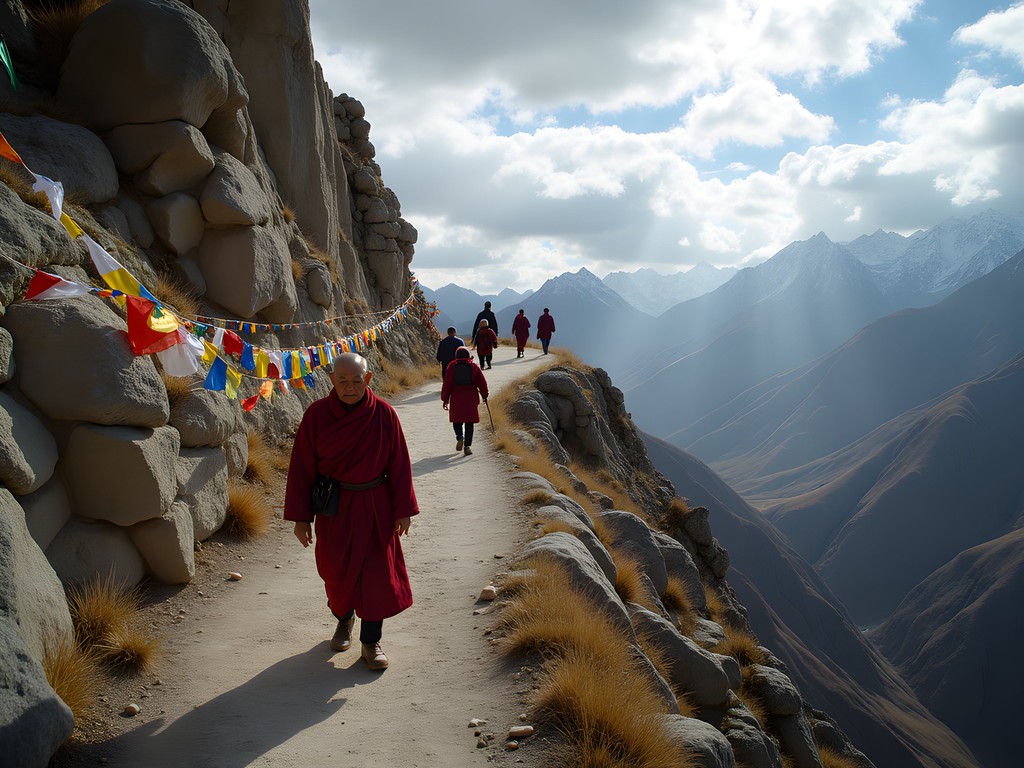
💡 Pro Tips
- Walk koras in a clockwise direction to respect local customs
- Carry small denominations of yuan for offerings at shrines along the circuits
- Time your Ganden kora for early morning to avoid afternoon storms common in summer months
Jokhang Temple: The Beating Heart of Tibetan Buddhism
If the Potala Palace represents Buddhism's architectural grandeur, the Jokhang Temple embodies its living soul. Nestled in the labyrinthine heart of Lhasa's old town, this 7th-century temple houses Tibet's most revered Buddha statue—the Jowo Shakyamuni, reportedly crafted during the Buddha's lifetime.
The approach through Barkhor Street creates a sensory immersion unlike anything I've experienced in two decades of travel journalism. The circuit surrounding Jokhang thrums with devotional energy as pilgrims from across the Tibetan plateau—many having walked hundreds of kilometers—complete their prostrations before entering the temple complex.
I arrived at dawn to witness the temple awakening. Monks in crimson robes performed morning rituals as the scent of juniper incense and yak butter lamps created an olfactory connection to centuries past. The low, rhythmic chanting seemed to vibrate through the ancient wooden floors, creating a resonance that felt both alien and strangely familiar.
Inside, the temple's layout follows a mandala pattern—a physical representation of the Buddhist cosmology. Moving from outer chambers toward the central shrine housing the Jowo statue, the atmosphere grows increasingly charged with devotional intensity. In the inner sanctum, I watched as pilgrims who had journeyed for weeks approached the gilded statue, many overcome with emotion at completing their life's spiritual ambition.
A monk who spoke some English noticed my respectful observation and offered an unexpected insight: 'We don't worship the statue,' he explained, 'but what it awakens in ourselves.' This simple statement reframed my understanding of pilgrimage across all traditions—not as journey to a destination, but as catalyst for internal transformation.
The temple's upper terraces offer rare perspectives of Lhasa's old town juxtaposed against the modern Chinese development beyond. This visual contrast mirrors Tibet's contemporary reality—ancient traditions persisting alongside rapid change.
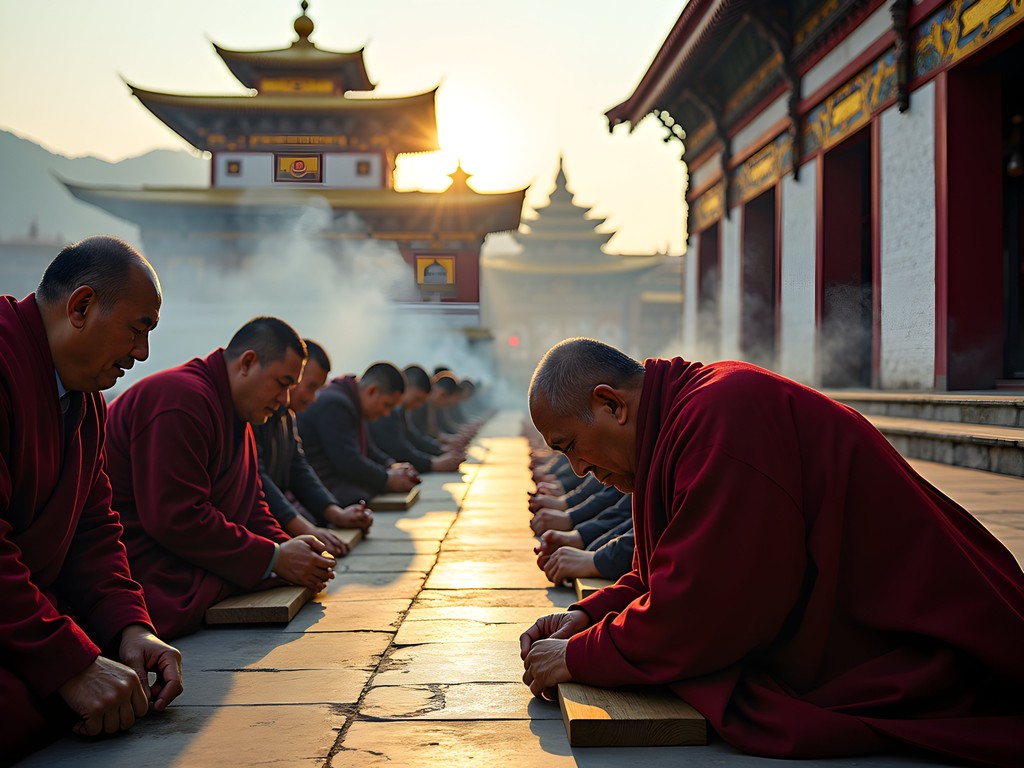
💡 Pro Tips
- Visit Jokhang twice: once early morning for rituals, then again mid-afternoon when lighting inside the temple is best
- Respect photography restrictions inside the temple—many sacred areas prohibit cameras
- Dress modestly with shoulders and knees covered, and remove hats before entering temple buildings
Beyond Lhasa: Sacred Lakes and Remote Monasteries
While Lhasa's sacred sites form the cornerstone of most Tibetan pilgrimages, the spiritual landscape extends far beyond the capital. My journey continued westward along routes that have connected Tibetan communities for centuries, revealing how geography itself becomes sacred through cultural meaning.
Yamdrok Lake, one of Tibet's three sacred lakes, appears like a shattered sapphire against the arid plateau. Reaching it requires crossing the 4,790-meter Kamba La pass, where the thin air makes each step deliberate. Local tradition holds that the lake is the transformation of a goddess, and its turquoise waters certainly possess an otherworldly quality that challenges photographic capture. I spent a contemplative afternoon watching nomadic herders move yak along the shoreline—their practical relationship with this sacred landscape offering lessons in sustainable coexistence.
Farther west, Samye Monastery represents a pivotal site in Tibetan Buddhism as the first formal monastery established in the 8th century. Its architecture replicates a mandala pattern visible only from above, with the main temple representing Mount Meru—the center of the Buddhist universe. What struck me most was not the historical significance but the living tradition; young monks debated philosophical concepts in the courtyard with the same animated gestures used for centuries, while senior teachers observed with subtle nods of approval or correction.
At these remote sites, I relied heavily on my satellite communicator to maintain safety protocols and connection with my guide when exploring more isolated areas. The device's ability to send preset messages confirming my well-being provided peace of mind without disrupting the contemplative nature of these sacred spaces.
These journeys beyond Lhasa revealed Tibet's spiritual geography as a complex network where natural features, historical events, and religious significance overlap. Unlike sporting venues that are constructed for specific purposes, these sacred landscapes emerge organically from cultural meaning accrued over centuries—a lesson in how humans create significance through collective belief and practice.
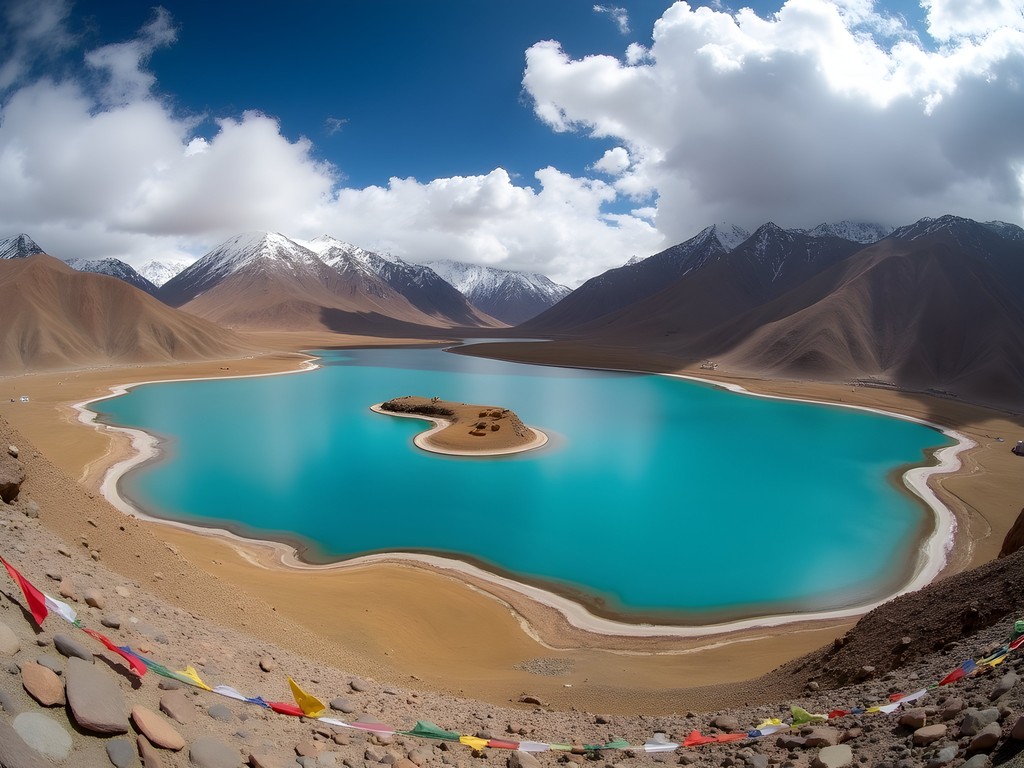
💡 Pro Tips
- Arrange permits for sites outside Lhasa at least 3 months in advance
- Respect local customs at sacred lakes by never throwing objects into the water or disturbing wildlife
- When visiting remote monasteries, bring appropriate offerings (barley flour, butter, or modest donations) rather than just taking photos
Final Thoughts
As my two-week pilgrimage through Tibet drew to a close, I found myself changed in ways both subtle and profound. The journalist in me had documented the external journey—the architectural marvels, the cultural practices, the ecological contexts. But like the pilgrims I'd observed, something deeper had transpired beyond professional observation. The Tibetan concept of nangpa—looking inward—had become more than academic understanding; it had become practice. In a world increasingly defined by digital distraction and fractured attention, Tibet's sacred landscapes offer a rare invitation to presence and contemplation. Whether you approach Tibet as spiritual seeker, cultural explorer, or simply curious traveler, the journey demands and rewards complete engagement. As I prepare to return to Wellington, I carry with me not just photographs and notes, but a renewed appreciation for traditions that connect human experience across time and space. The path awaits those willing to take that first breathless step.
✨ Key Takeaways
- Proper altitude acclimatization is non-negotiable for a meaningful Tibetan experience
- The most profound moments often come during unplanned encounters with local practitioners rather than at major sites
- Tibet's sacred geography offers lessons in sustainability and the deep connection between landscape and cultural identity
📋 Practical Information
Best Time to Visit
May-September, with July-August offering warmest temperatures but more crowds
Budget Estimate
$2,500-3,500 USD for a 2-week journey including permits, guide, transportation, and mid-range accommodations
Recommended Duration
Minimum 10 days, ideally 14-16 days to include sites beyond Lhasa
Difficulty Level
Challenging Due To Altitude, Permit Requirements, And Basic Facilities Outside Major Centers
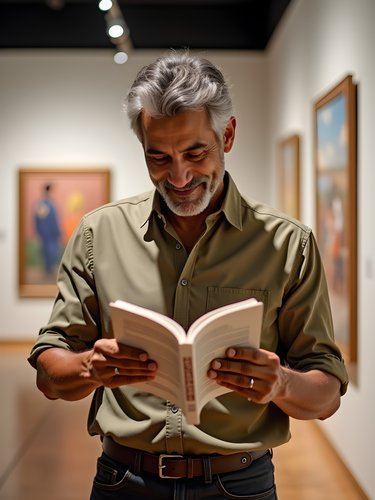
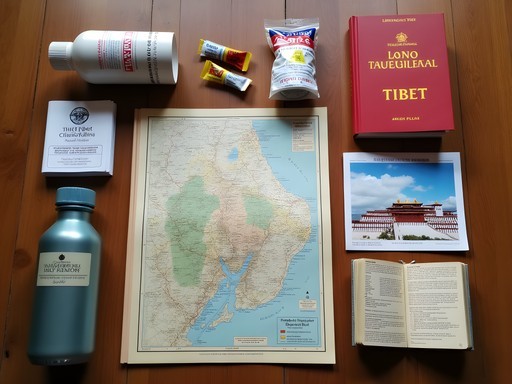
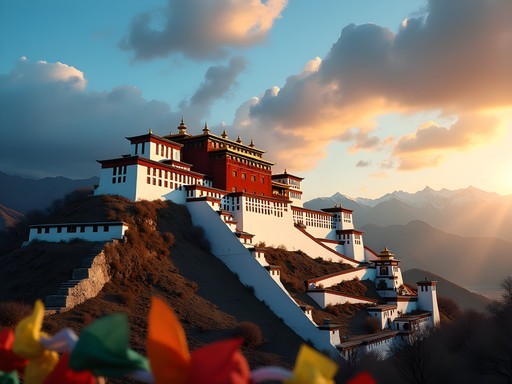
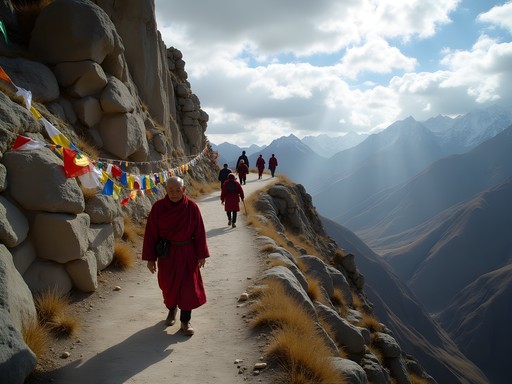
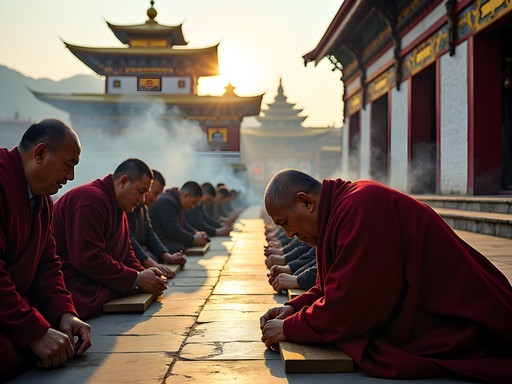



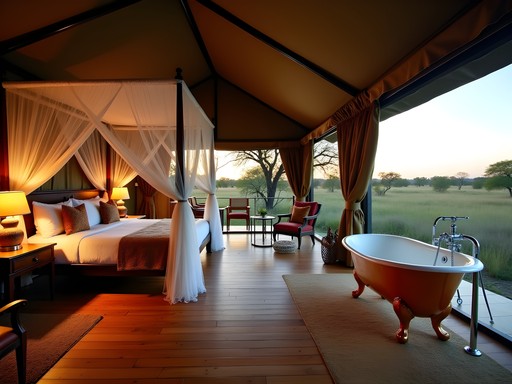
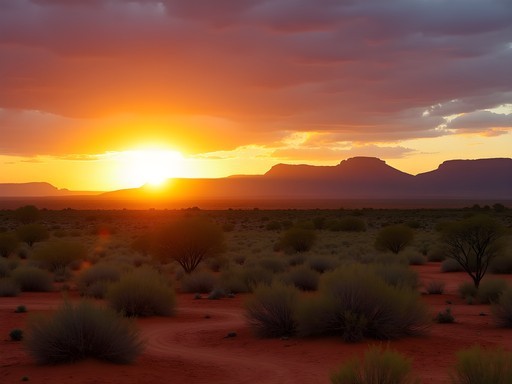



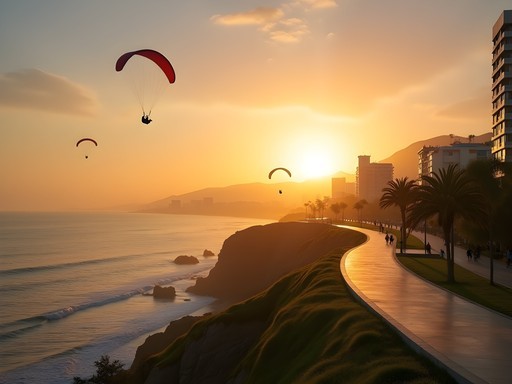


Comments
Nicole Russell
Amit, your post brought tears to my eyes. I did a similar solo journey through Tibet last winter, and that feeling you described of walking the kora with elderly pilgrims who've been making the same circuit for decades... it's humbling beyond words. The way you captured the contrast between the journalist observing and the human experiencing is spot on. Did you find yourself struggling with photography there? I remember feeling almost voyeuristic at times, yet desperately wanting to document the devotion I was witnessing. The balance between respectful observation and authentic participation was something I grappled with daily. Would love to hear more about how you navigated that aspect of the journey.
Amit Sullivan
Nicole, you've hit on exactly what I struggled with. I found myself putting the camera down more and more as days passed. Some moments felt too sacred for documentation. Eventually I settled on a rule - participate first, then ask permission if a photo felt important. Many of my most meaningful experiences went uncaptured except in memory, and I'm at peace with that now.
Nicole Russell
That's beautiful, Amit. I think that's the wisdom of these places - they teach us when to simply be present. Some experiences aren't meant to be filtered through a lens.
happybackpacker
Been there last year! Pro tip for anyone going: bring a pulse oximeter to monitor your oxygen levels. Saved me from pushing too hard on the first few days.
redmate
Good call on the oximeter. My doctor recommended the same thing when I went to Cusco.
explorestar
OMG this is EXACTLY the inspiration I needed!!! I've been dreaming about Tibet forever but always thought it was too complicated to arrange. Your post makes me feel like it's actually doable! Those sunrise photos of the Potala Palace are INCREDIBLE! Adding this to my 2026 plans for sure!!! 😍🙏✨
sunsetguide3498
Your photos are STUNNING! Especially that sunrise shot at Jokhang Temple! 😍
redmate
Great post! I'm planning a trip next year. How difficult was it to get the permits? I've heard Tibet travel restrictions can be complicated.
Amit Sullivan
Thanks! Yes, permits are required and you need to book through a licensed tour operator - I used Tibet Vista. You'll need a Tibet Travel Permit plus additional permits depending on which areas you visit. The process took about 3 weeks for approval. Happy to share more details if you DM me!
Olivia Sanchez
Amit, your description of that first glimpse of the Potala Palace took me right back to my own visit three years ago. There's something about the way it rises from the mountain that literally stops you in your tracks. I remember sitting for hours just watching the light change on those white walls. The kora experience you described around Barkhor Street was also a highlight for me - joining locals in their daily ritual feels like such a privilege. Did you try the butter tea? It took me days to acquire the taste, but by the end of my trip I was craving it!
coolguy
Man, that altitude sounds brutal! Did you get sick at all?
Amit Sullivan
First day was rough - headache and shortness of breath. Took it super slow and drank tons of water. By day three I was mostly adjusted!
coolguy
Good to know! I get winded just climbing stairs lol
moonrider
How many days would you recommend for Lhasa? Is two weeks necessary or could I see the highlights in less time?
redmood
Not the author but I did 5 days just in Lhasa and felt it was enough for the main sites. Two weeks would let you explore beyond to places like Shigatse and maybe even EBC.
travelvibes
Just got back from Tibet last month! For anyone planning to photograph the Potala Palace, I found my telephoto lens essential for capturing details of the architecture from various viewpoints around the city. Amit, did you experience any restrictions on photography inside the temples? I found it varied quite a bit between different sites.
Amit Sullivan
Great point about the telephoto! Yes, photography restrictions were inconsistent. Generally no photos inside main shrine rooms, but some of the corridors and peripheral rooms were okay. I always asked the monks first - sometimes paying a small camera fee opened up more options.
travelvibes
That matches my experience too. The early morning light on the pilgrims at Jokhang was my favorite photo opportunity of the whole trip.
explorehero
Just got back from Tibet myself. One thing to add - the security checks around Potala Palace and Jokhang are intense. Bring your passport everywhere, and don't take photos of police or military. Also, be prepared for your guide to be with you pretty much all the time outside Lhasa. It's required but also helpful for cultural context.
Venture X
Premium card with 2X miles, $300 travel credit, Priority Pass